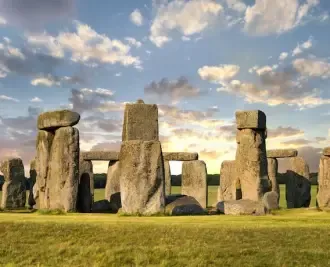Stonehenge Mystery Solved, Scientists Claim: Giant Stones Moved On Ancient ‘Highway’ From Wales To Salisbury

Hi steemit friends today sow you mystery stones and define what is this
The controversy over how the giant stones of Stonehenge were moved to the Salisbury plain is now over, a new study claims — but is it, really?
As thousands of modern-day pagans, Wiccans, history buffs and just plain tourists gathered on England’s Salisbury Plain to celebrate the summer solstice at the ancient monument of Stonehenge on June 21, as the covered, a pair of British scientists were saying that they have finally solved one of the most enduring puzzles surrounding the mystical site — how did the prehistoric builders of Stonehenge transport the massive stones to Salisbury, more than 5,000 years ago?
Publishing their research in the academic journal , Richard Bevins of the Museum of Wales and Rob Ixer of the University of Leicester say that they have identified a network of ancient “highways” consisting of both roads and rivers leading from Wales to the Stonehenge site. The stone age construction workers placed the stones on rollers and using animals to haul them — including the massive, 12,000-pound monolith known as the “Altar Stone” — from the Senni Beds in Wales and other newly identified locations, to the Stonehenge site more than 100 miles away, the scientists say.
For the last 95 years, the widely accepted theory has been the one proposed by geologist Herbert Henry Thomas, who identified a site at Carn Menyn in Pembrokeshire, Wales, as the source of the stones and said that the ancient builders must have transported the stones largely over the sea, as recounted in an article about Stonehenge theories 
“New analytical techniques, alongside transmitted and reflected light microscopy, have recently prompted renewed scrutiny of Thomas’ work,” said Bevins and Ixer, as quoted by . “While respectable for its time, the results of these new analyses, combined with a thorough checking of the archived samples consulted by Thomas, reveal that key locations long believed to be sources for the Stonehenge bluestones can be discounted in favor of newly identified locations at Craig-Rhos-y-felin and Carn Goedog.”
The route in the new theory runs almost entirely on land, needing only to cross the River Severn, according to a account of the Bevins-Ixer theory. In Thomas’s original 1923 paper, he proposed a route that stayed mostly on the water, tracing the outline of the Welsh coast until hitting land at a point near what today would be the English city of Bristol.
Building the ancient monument would have involved hundreds of people from several different ancient communities over a period of centuries, and probably had as much spiritual, political and ceremonial significance as the rituals held at the monument itself, according to what researchers told The Mail.
“In contemporary Western culture, we are always striving to make things as easy and quick as possible, but we believe that for the builders of Stonehenge this may not have been the case,” historian Susan Greany told the paper. “Drawing a large number of people from far and wide to take part in the process of building was potentially a powerful tool in demonstrating the strength of the community to outsiders.”
The act of building Stonehenge was as significant as the rituals held at the site itself, historians say. Hey Woody/iStock Photos
Despite the scientists’ claim to have solved the ancient mystery of how Stonehenge was constructed, the controversy will likely continue. As reported last month, a new book by Welsh scientist Brian John argues that at least some often stones, known as bluestones, were not transported from Wales to Salisbury by humans at all.
Please comment
Follow 
upvote for me please? https://steemit.com/news/@bible.com/2sysip